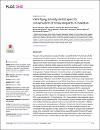Identifying priority landscapes for conservation of snow leopards in Pakistan
| المؤلف | Hameed, Shoaib |
| المؤلف | ud Din, Jaffar |
| المؤلف | Ali, Hussain |
| المؤلف | Kabir, Muhammad |
| المؤلف | Younas, Muhammad |
| المؤلف | Ur Rehman, Ejaz |
| المؤلف | Bari, Fathul |
| المؤلف | Hao, Wang |
| المؤلف | Bischof, Richard |
| المؤلف | Nawaz, Muhammad Ali |
| تاريخ الإتاحة | 2023-10-05T05:55:40Z |
| تاريخ النشر | 2020-11-05 |
| اسم المنشور | PLoS ONE |
| المعرّف | http://dx.doi.org/10.1371/journal.pone.0228832 |
| الاقتباس | Hameed, S., Din, J. U., Ali, H., Kabir, M., Younas, M., Ur Rehman, E., ... & Nawaz, M. A. (2020). Identifying priority landscapes for conservation of snow leopards in Pakistan. PLoS One, 15(11), e0228832. |
| الرقم المعياري الدولي للكتاب | 1932-6203 |
| الملخص | Pakistan's total estimated snow leopard habitat is about 80,000 km2 of which about half is considered prime habitat. However, this preliminary demarcation was not always in close agreement with the actual distribution-the discrepancy may be huge at the local and regional level. Recent technological developments like camera trapping and molecular genetics allow for collecting reliable presence records that could be used to construct realistic species distribution based on empirical data and advanced mathematical approaches like MaxEnt. The current study followed this approach to construct an accurate distribution of the species in Pakistan. Moreover, movement corridors, among different landscapes, were also identified through circuit theory. The probability of habitat suitability, generated from 98 presence points and 11 environmental variables, scored the snow leopard's assumed range in Pakistan, from 0 to 0.97. A large portion of the known range represented low-quality habitat, including areas in lower Chitral, Swat, Astore, and Kashmir. Conversely, Khunjerab, Misgar, Chapursan, Qurumber, Broghil, and Central Karakoram represented high-quality habitats. Variables with higher contributions in the MaxEnt model were precipitation during the driest month (34%), annual mean temperature (19.5%), mean diurnal range of temperature (9.8%), annual precipitation (9.4%), and river density (9.2). The model was validated through receiver operating characteristic (ROC) plots and defined thresholds. The average test AUC in Maxent for the replicate runs was 0.933 while the value of AUC by ROC curve calculated at 0.15 threshold was 1.00. These validation tests suggested a good model fit and strong predictive power. The connectivity analysis revealed that the population in the Hindukush landscape appears to be more connected with the population in Afghanistan as compared to other populations in Pakistan. Similarly, the Pamir-Karakoram population is better connected with China and Tajikistan, while the Himalayan population was connected with the population in India. Based on our findings we propose three model landscapes to be considered under the Global Snow Leopard Ecosystem Protection Program (GSLEP) agenda as regional priority areas, to safeguard the future of the snow leopard in Pakistan and the region. These landscapes fall within mountain ranges of the Himalaya, Hindu Kush and Karakoram-Pamir, respectively. We also identified gaps in the existing protected areas network and suggest new protected areas in Chitral and Gilgit-Baltistan to protect critical habitats of snow leopard in Pakistan. |
| اللغة | en |
| الناشر | Public Library of Science |
| الموضوع | ecosystem leopard |
| النوع | Article |
| رقم العدد | 11 |
| رقم المجلد | 15 |
الملفات في هذه التسجيلة
هذه التسجيلة تظهر في المجموعات التالية
-
العلوم البيولوجية والبيئية [938 items ]


